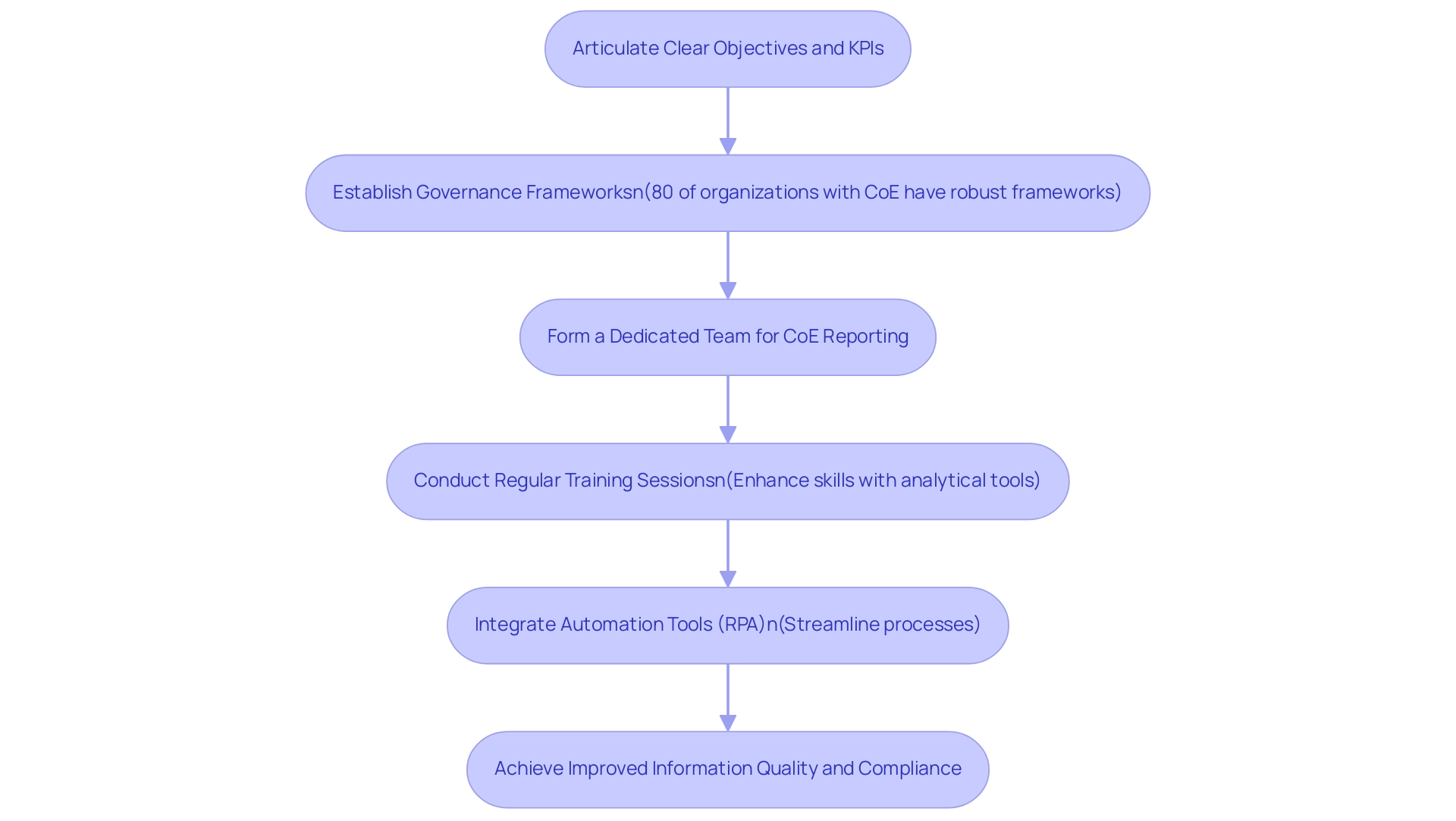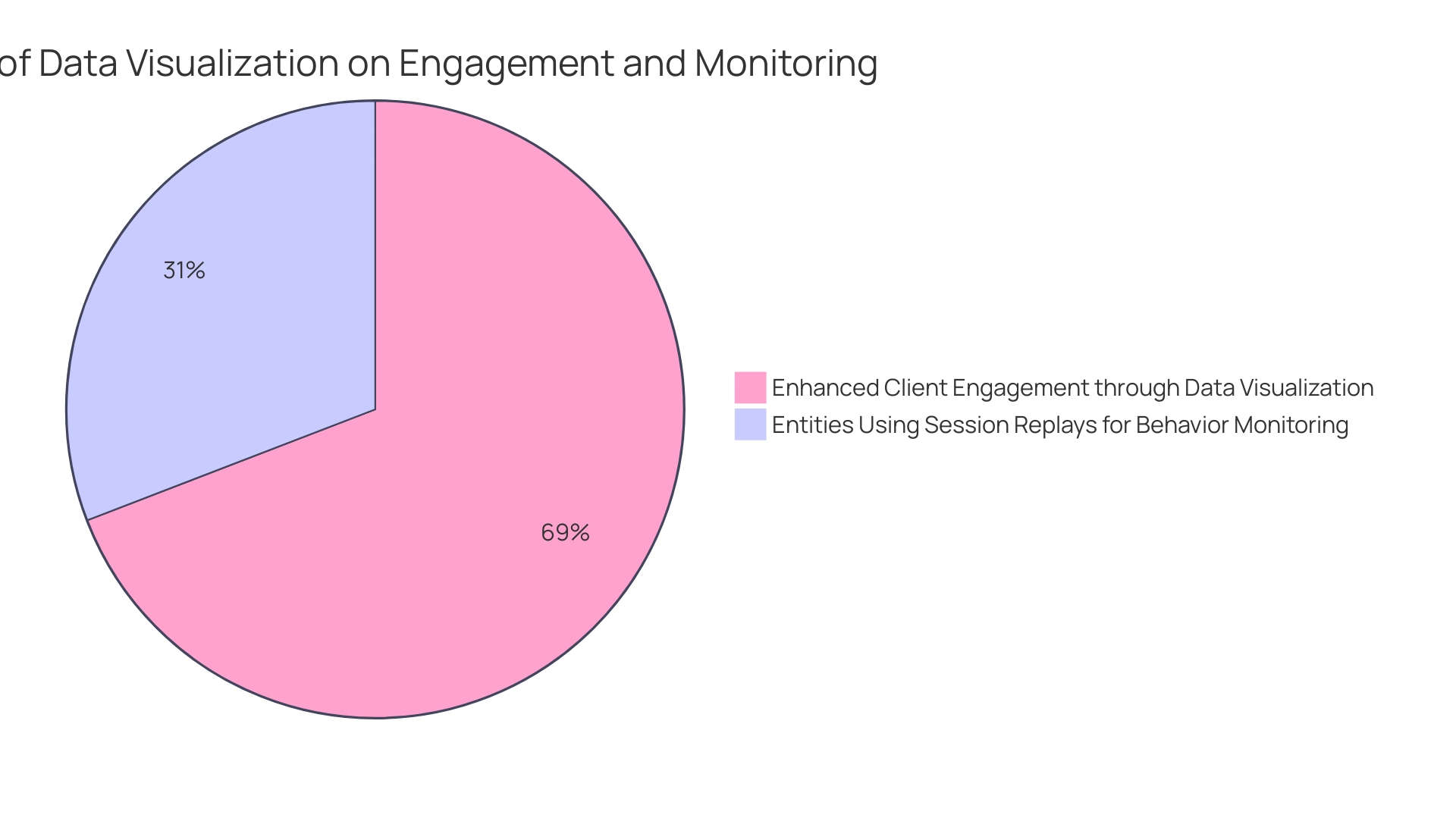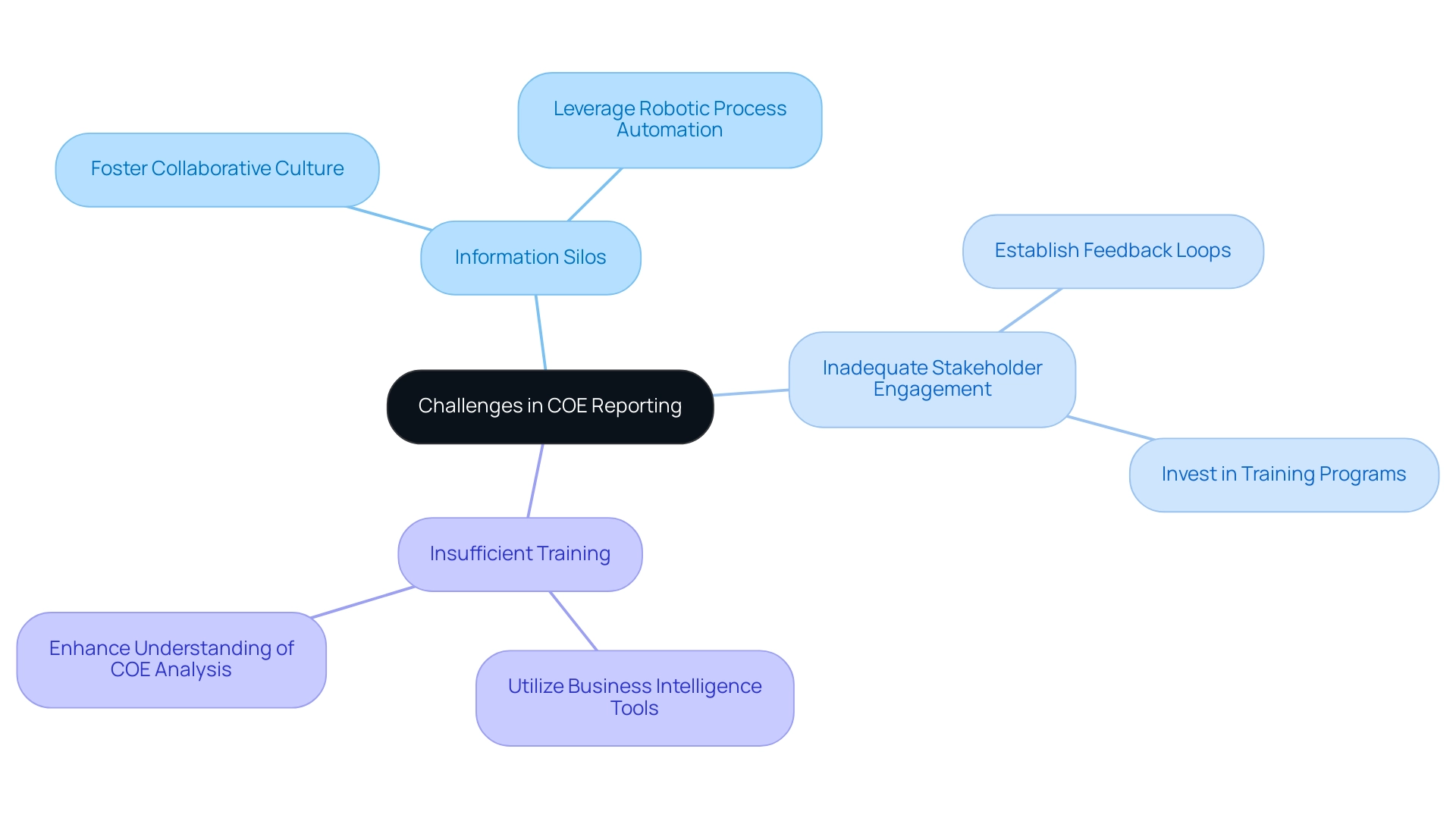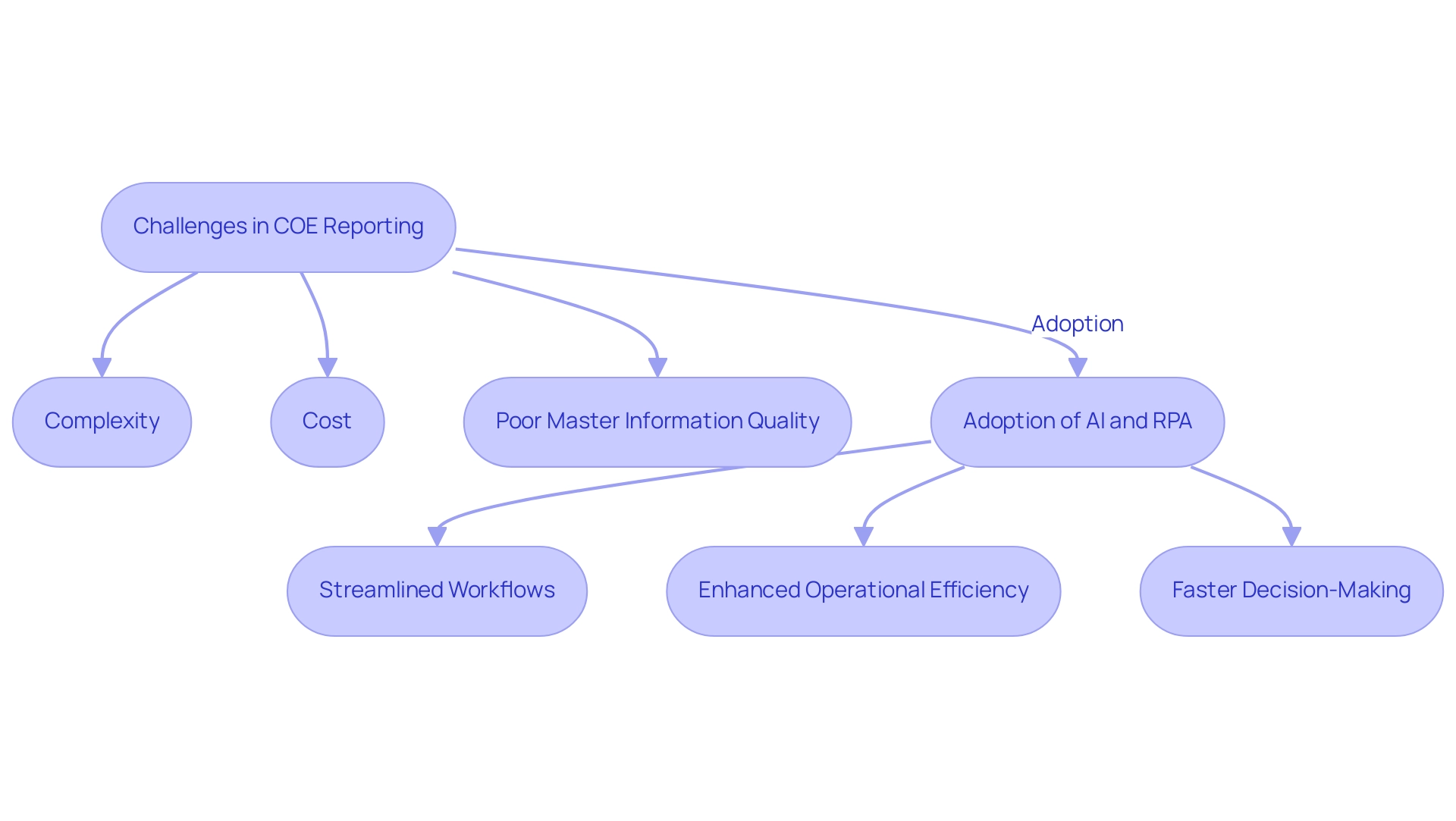Introduction
In the realm of operational excellence, the significance of Center of Excellence (COE) reporting cannot be overstated. As organizations strive to enhance performance and drive strategic initiatives, effective COE reporting emerges as a critical tool for uncovering insights that propel continuous improvement.
By harnessing advanced technologies such as Robotic Process Automation (RPA) and data visualization tools like Power BI, businesses can streamline their reporting processes, reduce inefficiencies, and foster a culture of accountability and collaboration.
This article delves into the fundamentals of COE reporting, offering practical strategies for implementation, overcoming common challenges, and embracing future trends that will shape the landscape of organizational reporting.
As companies navigate the complexities of data management, understanding how to leverage these insights will empower them to make informed decisions and achieve lasting success.
Understanding the Fundamentals of COE Reporting
COE reporting serves as a cornerstone for enhancing organizational performance by delivering vital insights into process efficiencies and identifying areas ripe for improvement. With innovative tools like EMMA RPA, which automates repetitive tasks and enhances operational efficiency, and Microsoft Power Automate, which streamlines workflows and integrates various applications, organizations can tackle challenges such as outdated systems and staffing shortages, ultimately improving employee morale. For example, the recent decline in master’s degrees awarded in Business, from 205,800 to 202,400, highlights the necessity for educational institutions to adjust their strategies and enhance operational effectiveness through strong COE documentation.
It is essential to comprehend fundamental metrics like throughput, cycle time, and error rates, as these figures provide a quantifiable basis for assessing operational health. Establishing clear objectives—whether it be reducing operational costs or elevating service delivery standards—is paramount to aligning COE reporting with broader business goals. Furthermore, the importance of stakeholder engagement cannot be overstated.
Effective communication throughout the documentation process ensures that the needs and expectations of all parties are met, fostering a collaborative environment that drives success. As Tameka Ellington from Upward Bound at Cuyahoga Community College emphasizes, ‘Engaging stakeholders is not just beneficial; it’s essential for meaningful outcomes in any reporting initiative.’
The case study on a mid-sized company that implemented GUI automation to streamline operations illustrates how automating information entry and system integration reduced errors by 70% and improved workflow efficiency by 80%.
The automation addressed challenges such as manual data entry errors and slow software testing, showcasing how these tools can revolutionize processes. By concentrating on these elements, entities can utilize COE reporting not only to improve their operational efficiency but also to foster a culture of ongoing enhancement.

Expert Tips for Effective COE Reporting Implementation
To implement coe reporting effectively, entities should commence by articulating clear objectives and key performance indicators (KPIs) that are directly aligned with their overarching strategic goals. This foundational step is critical, as robust governance frameworks are established in 80% of organizations with coe reporting from a Center of Excellence (CoE), compared to only 45% of those lacking one. According to the Big Information Framework, ‘A CoE enhances governance and quality by establishing and enforcing comprehensive governance frameworks that include policies, standards, and best practices for management.’
A dedicated team focused on coe reporting not only ensures accountability but also fosters continuous improvement across processes. Regular training sessions to improve team members’ skills with analytical tools and software are essential, empowering individuals to harness the full potential of technologies like Power BI. Furthermore, the integration of automation tools, such as robotic process automation (RPA), can significantly streamline information collection and reporting processes, addressing the common challenges of repetitive tasks and outdated systems.
This reduces manual errors and frees up valuable time for deeper analysis, ultimately resulting in improved information quality and compliance with regulations through coe reporting. For instance, the 3-Day Power BI Sprint promises to deliver a fully functional, professionally designed report on a topic of your choice in just three days. This allows teams to focus on insights rather than construction and provides a template for future projects, ensuring a professional design from the start.
A report by the Data Governance Institute emphasizes that entities with a Code experience enhanced information quality and regulatory compliance, showcasing the concrete advantages of implementing these frameworks. These best practices are crucial as organizations seek to utilize science as a catalyst for transformation in governance and performance assessment while tackling repetitive tasks and improving overall productivity.

The Role of Data Visualization in COE Reporting
Effective information visualization is essential in COE documentation and coe reporting, as it allows stakeholders to swiftly interpret intricate datasets and make informed choices. With 65% of companies indicating that integrating visual representation into presentations significantly enhances client engagement, the significance of tools like Power BI cannot be overstated. Our Power BI services, featuring the 3-Day Power BI Sprint for quick report generation and the General Management App for thorough supervision, are intended to improve your information presentation abilities.
The General Management App features intuitive dashboards and real-time analytics, allowing for smarter decision-making. Additionally, our Actions portfolio offers tailored solutions to optimize your coe reporting processes, and we invite you to book a free consultation to explore how we can assist you further. As companies increasingly utilize technologies such as Robotic Process Automation (RPA) for workflow efficiency and customized AI solutions for specific business objectives, the incorporation of these tools can simplify report generation and tackle typical issues like information inconsistencies and actionable guidance.
Indeed, a rising trend indicates that 29% of entities are employing session replays to monitor behavior, further highlighting the necessity for efficient analysis practices. As we navigate an information-rich environment—five times more than in 1986—tailoring visualizations to specific audiences, whether executives or operational teams, becomes crucial. This targeted method not only boosts engagement but converts raw information into impactful insights, ultimately propelling organizational growth.
However, many organizations still encounter obstacles in adopting these techniques; thus, understanding and applying best practices in visualization and leveraging Business Intelligence are essential for nurturing a culture driven by information within your organization.

Navigating Challenges in COE Reporting
COE documentation frequently faces various obstacles, including:
- Information silos
- Inadequate stakeholder engagement
- Insufficient training
Historical data extending from 2007 to 2024 uncovers ongoing challenges in COE reporting that necessitate a proactive approach. To address these issues, organizations can foster a collaborative culture by actively engaging all relevant departments throughout the documentation process.
Leveraging Robotic Process Automation (RPA) can automate manual workflows, which not only boosts efficiency and reduces errors but also frees up teams to focus on more strategic, value-adding tasks. Establishing regular feedback loops is essential; they ensure that the framework continuously evolves in response to stakeholder input, fostering a sense of ownership and accountability. As highlighted in the case study ‘Bridging Communication Gaps in Offshore Drilling Teams,’ embracing cultural differences and utilizing technology can enhance teamwork and safety, serving as a model for overcoming communication barriers.
Furthermore, investing in comprehensive training programs significantly enhances employees’ understanding of COE analysis and COE reporting, utilizing Business Intelligence tools that transform raw data into actionable insights. This proactive approach not only mitigates resistance to change but also nurtures a data-driven culture that empowers teams to leverage insights effectively. As we progress towards 2024, tackling these common challenges will be vital for enhancing effectiveness and attaining operational excellence.
As a guiding principle, entities should ‘ensure financial consistency by aligning accounting practices in a merger,’ which underscores the importance of stakeholder engagement and collaboration in leveraging RPA and Business Intelligence for informed decision-making in an evolving AI landscape.

Future Trends in COE Reporting Practices
The landscape of COE documentation is experiencing a substantial change propelled by technological advancements, especially as entities strive to address obstacles in implementing AI. The incorporation of artificial intelligence (AI) and machine learning (ML) is transforming how entities examine information, enabling deeper insights and more effective reporting procedures. However, many directors hesitate to adopt these technologies due to perceptions of complexity, cost, and concerns about poor master information quality, which can lead to inefficient operations and flawed decision-making.
By leveraging tailored AI solutions and Robotic Process Automation (RPA), companies can streamline workflows, reduce manual tasks, and enhance operational efficiency. For instance, in the first follow-up of the NPSAS:12 study, 24,770 out of 35,540 eligible sample students responded, resulting in a 70% unweighted response rate, underscoring the significance of effective information collection in understanding educational trends. These technologies empower teams to sift through vast amounts of information quickly, identifying patterns and trends that may have otherwise gone unnoticed.
Furthermore, the use of real-time monitoring tools gives entities instant access to pertinent information, facilitating faster decision-making—a crucial benefit in today’s rapid-paced landscape. As stakeholders place a greater emphasis on ethical information practices, organizations must also prioritize transparency in their reporting. Aurora D’Amico from the National Center for Education Statistics emphasizes, ‘Further information on NPSAS may be obtained from our office,’ highlighting the significance of accessible information for informed decision-making.
Upholding high standards of ethics not only builds trust with stakeholders but also aligns with the growing demand for responsible use of information. A pertinent example is the School Shooting Database Project, which records instances of gun-related incidents in K-12 schools, compiling information from various sources into a comprehensive database. By proactively embracing these trends and leveraging RPA alongside AI, entities can significantly enhance their COE reporting practices, leading to improved operational efficiency and informed strategic decisions.
Furthermore, the importance of Business Intelligence in transforming raw data into actionable insights cannot be overstated, as it plays a crucial role in ensuring that organizations remain competitive and responsive to changing market demands.

Conclusion
Embracing effective Center of Excellence (COE) reporting is vital for organizations aiming to enhance operational performance and foster a culture of continuous improvement. By leveraging advanced technologies such as Robotic Process Automation (RPA) and data visualization tools like Power BI, companies can streamline their reporting processes, tackle inefficiencies, and engage stakeholders more effectively. Understanding the fundamentals of COE reporting, including key performance indicators (KPIs) and stakeholder engagement, lays the groundwork for achieving strategic goals and driving meaningful outcomes.
Organizations must prioritize training and the establishment of data governance frameworks to fully realize the benefits of COE reporting. By integrating automation and visualization techniques, teams can transform complex datasets into actionable insights, ultimately facilitating informed decision-making. As businesses navigate the challenges of data silos and inadequate engagement, the adoption of a collaborative culture and regular feedback loops will enhance reporting effectiveness and empower employees to leverage insights for operational excellence.
Looking ahead, the future of COE reporting is poised for transformation as AI and machine learning technologies become increasingly integrated into reporting practices. Organizations that proactively embrace these innovations will not only improve their operational efficiency but also position themselves to respond swiftly to changing market demands. By committing to ethical data practices and transparency, companies can build trust with stakeholders and ensure their reporting frameworks remain robust and relevant. Ultimately, the journey toward operational excellence through COE reporting is an ongoing process that requires dedication, adaptability, and a focus on continuous improvement.
